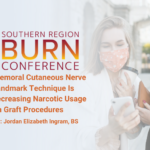Abstract | December 20, 2021
Use Of Lateral Femoral Cutaneous Nerve Blocks By Landmark Technique Is Ineffective In Decreasing Narcotic Usage After Skin Graft Procedures
Learning Objectives
- Describe the mechanism by which lateral femoral cutaneous nerve blocks should reduce preoperative pain.
- Recognize the effect of lateral femoral cutaneous nerve blocks on skin graft donor site pain.
Introduction:
Cutaneous burns are commonly treated with autologous skin grafts. Following skin grafting, many patients complain of pain at the donor site. The donor sites are taken most commonly from the lateral thigh, which is innervated by the lateral femoral cutaneous nerve (LFCN). Use of a LFCN blocks should decrease nociception from the donor site.
Methods:
Our group began utilizing LFCN blocks in late 2019. Utilizing anatomic landmarks, a LFCN blocks were performed on all patients who received autologous skin grafts to reduce perioperative pain. A retrospective cohort study was performed on all patients with 10% or less total body surface areas burns who received an autologous skin graft. A similar cohort from 2016, prior to use of any local or regional analgesia, was used as a historical control. Post-operative enteral and parenteral narcotic analgesics were collected for each post-operative day up to day 5 or discharge (whichever came first) and converted to morphine milligram equivalents (MME) to quantify analgesia after surgery.
Results:
Chart review identified 55 patients in the 2020 cohort. Fifty-five patients from the 2016 cohort were matched based upon the applied graft size, total body surface area (TBSA) burned, gender, and age. There were no statistically significant differences between the two groups in terms of size of graft, TBSA burned, age, gender, or type of burn. When examining narcotics usage in the immediate perioperative period (days 0- 2), there was no difference between the 2020 cohort and 2016 cohort for average total MME (139.29 vs 146.53, p=0.70) or IV MME (43.21 vs 36.86, p=0.27). Similar relationships existed in the extended post-operative period (days 1-5) for total MME (258.07 vs. 249.95, p=0.86) or IV MME (49.09 vs. 66.78, p=0.29). Comparing daily narcotic usage between the two groups also yielded no statistically different values.
Conclusion:
Our data shows that use of LFCN block by landmark technique did not reduce narcotic usage in patients that undergo skin grafting procedures. Future studies should consider ultrasound-guided LFCN blocks.

